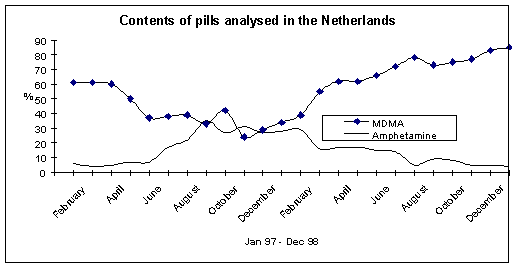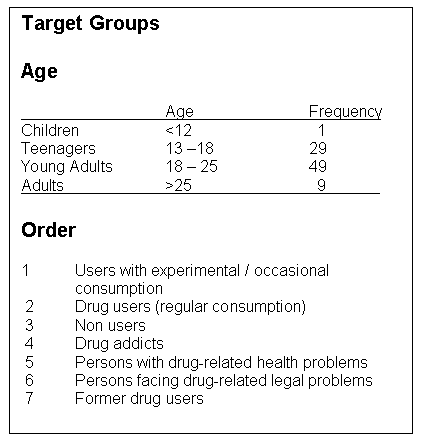| Articles - Demand reduction |
Drug Abuse
Demand reduction activities in the European Union
Deborah Olszewski & Gregor Burkhart
Demand Reduction, EMCDDA, Rua Cruz De Sta. Apolonia 23-25, Lisbon, 1149-045, Portugal. Phone no: +351-1811 3022 Fax no: +351-1813 7943
E-mail: This e-mail address is being protected from spambots. You need JavaScript enabled to view it
In our epidemiology department we have traditionally depended on key indicators for drug use, based on population surveys, school surveys, treatment data, drug problem prevalence estimates and so on. However, these data are always dated because there is a time lag even in receiving the information, not to mention in analysing it. Data from all the European member states who provide us with information is out of date by the time it reaches Lisbon, where the European Monitoring Centre for Drugs and Drug Addiction (EMCDDA) is based.
For instance, if we look at lifetime prevalence (that is the number of times ever used say for amphetamines, ecstasy and LSD) then Irish use of LSD looks very peculiar. This is because in Ireland the survey method includes magic mushrooms whereas other countries do not. There is therefore a problem with surveys in how people respond and what drugs they include. So in fact, LSD sometimes includes magic mushrooms and other hallucinogenic type substances.

Obviously the issue about amphetamines is a difficult one. People are taking pills thinking they are ecstasy, when in fact they contain amphetamine. Of course, this is not going to be picked up in surveys but we are very aware of the problem. If we look at the last twelve months prevalence (that is whether a person has used these drugs in the last twelve months) this again shows interesting variations between countries. Britain has a very high continued use of amphetamines, very much higher than any other country. Whether or not this reflects the reality or merely the survey methods, it is still remarkably higher than in the Netherlands.
In some countries’ data there is no distinction between amphetamines and ecstasy and this happens all too often. The Netherlands is unique in having an ongoing system for checking pills (through pill testing). We collect information reported to us from the Netherlands in their annual report. Less MDMA in the pills means more amphetamines, so there appears to be a clear relationship between the absence of MDMA and the increase in amphetamine. These data are for the period January 97 - December 98.
Very few countries have these types of data. In fact the Netherlands are the only country able to give us long-term data, although Austria has insisted that they have found an increase in amphetamines around a slightly later period but they do not have ongoing pill testing. That is the rather limited data that we have because traditionally the key indicators have concentrated on heroin and cocaine problems. What we are hoping to do at the EMCDDA is to get a much better understanding of new trends.
Ecstasy was an example to the research community of how terribly behind we have been since ecstasy was actually around over ten years ago. Most people working in the field - outreach workers, even local drug researchers - knew that ecstasy was about but studies were not being commissioned at a European level. In national surveys, ecstasy was not added until recently, so we are very conscious that we have to find methods of monitoring new trends and not be the last to be doing work on it when everyone else is.
It is very clear that the information is out there. It is not as if we have to create a new system to get the information. It is out there in people’s heads and in their daily life, whether they are outreach workers, whether they are drug users, help-line agencies, members of the media or whatever. We want to try and develop a monitoring system which takes into account all these different data sources and filters the information through experts from a wide variety of professions, depending on what we are looking at, so that appropriate experts are used to assess the data. Much of the soft data will not be statistically significant but semi-anecdotal and people are very shy or for a variety of reasons do not want to let go of anecdotal data. One, because they think it is inadequate or they do not want the press to get hold of it or, two, they do not want to give it away for free.
So we are working on a system where we can try and get this data gathered together and then filter it through experts to find out what is worth feeding back; what is worth commissioning; and whether to undertake an investigation to look more closely at some new patterns of drug use. What we do know is that ecstasy is being used but there are enormous differences between the EU15 countries. There is a diversification of stimulants, including cocaine. Ketamine seems to be appearing more and more, as well as GHB and pharmaceuticals used with alcohol. We do not know very much in any routine systematic way about how this ecstasy market and the use of drugs in nightlife is diversifying. We want to focus on the heavier end of ecstasy use to see what is happening, primarily with health risks in mind at this stage.
Drug use in nightlife is clearly promoted by friendships, and dance party settings are an opportunity for people to witness other people’s drug use. It is clear that they make their own assessments about their safety based on what they see around them. The spread of this drug use among mainstream young people who have jobs is a different story from problematic heroin dependence. This raises many more questions that the EMCDDA cannot answer, but we obviously do have to look at what long-term, chronic health problems will be faced. There is a growing concern about the chronic long-term health effects of ecstasy use and how these problems will challenge health care services in the future, and that is setting aside any acute risks resulting from drug use. We have to look at what information we need to disseminate about drugs, what information we already have and what information we do not have. There is also a consumer issue here: people have the right to know about the contents of drugs.
So what do we need to know about the contents of substances and patterns of use? In this field we are constantly faced with how little we know. We know a little bit about pills from what toxicologists and forensic scientists are able to tell us from what they are getting in drug seizures or in other methods of testing. We really know very little. Some of the sources we are intending to use are: key person analyses; pill testing where it is available; the media and the internet; forensic and toxicology laboratories; help-lines; and where necessary we will commission outbreak investigations. That is not a comprehensive list; we are open to all sorts of other sources.
The idea is to try and develop what we would call ‘edge indicators’ - which gives it a sort of scientific feel - to transform anecdotal quantitative and qualitative material. By filtering it through experts, we can develop something that we call a leading edge indicator. The crucial aspect of this is the further assessment by appropriate experts because that is the only way we are going to assess this much looser data from a variety of sources. The definitive purpose of it is to produce rapid information in order to facilitate more appropriate policy making and target responses to local areas, as local initiatives are actually capable of handling what is going through on the dance floors.
By collecting stuff at European levels, information can be transmitted quite quickly from a local dance floor in Manchester to a dance floor in Lille, and there is information exchange there that could be very valuable. Our role at the EMCDDA will be to try to coordinate it and get it back out there for local responses, rather than national responses, and that is the epidemiology side.

From the point of view of demand reduction, it may be worth mentioning a study that the EMCDDA recently had commissioned to look at demand and harm reduction initiatives in Europe and which specifically targeted synthetic drug use. We looked at what data was collected from 52 projects and 74 contacts around Europe. The type of measures and actions that are being instigated at a European level are very heavily focused on the distribution of information materials, with that forming nearly 40% of all activities and therapy forming 5% of activities in responding to synthetic drug use. Generally in Europe there is an increase in the number of specific projects that are being set up to respond to what is called synthetic drug use, and there is a wider diversification of types of intervention.
There is an attempt at evaluating these projects but the majority of interventions are still addressing the drug abstainers or casual consumers. None of the people who need it most are benefiting most from the initiatives that exist. The real gap concerns the high risk consumers who are taking nine or ten pills a night rather than cautiously taking one or two and making an effort to find out what they taking before they take it. It is this group that is at a much higher risk who are least likely to be using the information materials that are available, and the evaluation standards and guidelines are still very slow at being implemented.

It would be nice to think that we can go around Europe collecting information without giving anything back but I think this information will operate much more intensively through information exchange, which will be immediate and, hopefully through the internet and websites, easier. At the moment, we are still in the early stages and, without being overly optimistic, I know from the people I have met so far that there is enthusiasm about sharing information. Of course, there are financial issues for funding but I do not think this will work unless it is based on a mutual information exchange, which will be immediate in that if someone provides me with information from Britain, I will tell them what I have heard from France.
There is also an issue about information from police sources and information from outreach workers. We are aware that this is a sensitive issue. People talking with an outreach worker in a dance party setting are not necessarily going to want us to go and tell the police sources what we have been told by them. This is a delicate area and we have to work very carefully around what information people are happy to exchange with us and what information they are not happy with. We are hoping to produce a bulletin about every six months which will have a summary of the key findings. We would therefore be producing something, maybe an electronic document, every six months, and this in turn has to be piloted.
The media is also a problem. If we produce information that is of interest to those of us working in the field, which is then distorted by the media, it could be quite damaging and harmful to the people involved. So how public can we go? We have to tread carefully and not start pushing out bulletins with stuff that only the media and some newspapers will use, as everyone else will be sceptical about it. I think it is a sensitive area, but initially I think we have to work on quite a human network of information exchange, based on exchange and trust.












